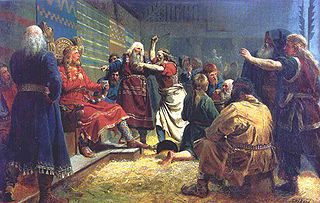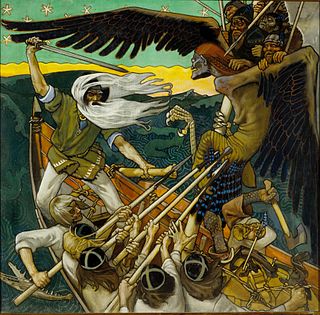
Poul William Anderson was an American fantasy and science fiction author who was active from the 1940s until his death in 2001. Anderson also wrote historical novels. He won the Hugo Award seven times and the Nebula Award three times, and was nominated many more times for awards.

Harald Fairhair was a Norwegian king. According to traditions current in Norway and Iceland in the eleventh and twelfth centuries, he reigned from c. 872 to 930 and was the first King of Norway. Supposedly, two of his sons, Eric Bloodaxe and Haakon the Good, succeeded Harald to become kings after his death.

Eric Haraldsson, nicknamed Bloodaxe and Brother-Slayer, was a Norwegian king. He ruled as King of Norway from 932 to 934, and twice as King of Northumbria: from 947 to 948, and again from 952 to 954.

Haakon Haraldsson, also Haakon the Good and Haakon Adalsteinfostre, was the king of Norway from 934 to 961. He was noted for his attempts to introduce Christianity into Norway.

Uther Pendragon (Brittonic), also known as King Uther, was a legendary King of the Britons and father of King Arthur.
Magic realism, magical realism, or marvelous realism is a style or genre of fiction and art that presents a realistic view of the world while incorporating magical elements, often blurring the lines between speculation and reality. Magical realism is the most commonly used of the three terms and refers to literature in particular. Magic realism often refers to literature in particular, with magical or supernatural phenomena presented in an otherwise real-world or mundane setting, commonly found in novels and dramatic performances. In his article "Magical Realism in Spanish American Literature", Luis Leal explains the difference between magic literature and magical realism, stating that, "Magical realism is not magic literature either. Its aim, unlike that of magic, is to express emotions, not to evoke them." Despite including certain magic elements, it is generally considered to be a different genre from fantasy because magical realism uses a substantial amount of realistic detail and employs magical elements to make a point about reality, while fantasy stories are often separated from reality. The two are also distinguished in that magic realism is closer to literary fiction than to fantasy, which is instead a type of genre fiction. Magical realism is often seen as an amalgamation of real and magical elements that produces a more inclusive writing form than either literary realism or fantasy.

In mythology, folklore and speculative fiction, shapeshifting is the ability to physically transform oneself through unnatural means. The idea of shapeshifting is found in the oldest forms of totemism and shamanism, as well as the oldest existent literature and epic poems such as the Epic of Gilgamesh and the Iliad. The concept remains a common literary device in modern fantasy, children's literature and popular culture. Examples of shapeshifters are vampires and werewolves.

Egill's Saga or Egil's saga is an Icelandic saga on the lives of the clan of Egill Skallagrímsson, an Icelandic farmer, viking and skald. The saga spans the years c. 850–1000 and traces the family's history from Egill's grandfather to his offspring.
Gudrid Thorbjarnardóttir was an Icelandic explorer, born at Laugarbrekka in Snæfellsnes, Iceland.

The Saga of Erik the Red, in Old Norse: Eiríks saga rauða, is an Icelandic saga on the Norse exploration of North America. The original saga is thought to have been written in the 13th century. It is preserved in somewhat different versions in two manuscripts: Hauksbók and Skálholtsbók.

Egil Skallagrímsson was a Viking Age war poet, sorcerer, berserker, and farmer. He is known mainly as the anti-hero of Egil's Saga. Egil's Saga historically narrates a period from approximately 850 to 1000 AD and is believed to have been written between 1220 and 1240 AD.

Three Hearts and Three Lions is a 1961 fantasy novel by American writer Poul Anderson, expanded from a 1953 novella by Anderson which appeared in Fantasy & Science Fiction magazine.

A Midsummer Tempest is a 1974 alternative history fantasy novel by Poul Anderson. In 1975, it was nominated for the World Fantasy Award for Best Novel and the Nebula Award for Best Novel and won the Mythopoeic Award.
Saint Cathróe was a monk and abbot. His life is recorded in a hagiography written soon after his death by a monk at the monastery of Saint Felix at Metz, where Cathróe was abbot. Miracles of healing were attributed to Cathróe during his life, and he was considered a saint after his death.

Gunnhildr konungamóðir or Gunnhildr Gormsdóttir, whose name is often Anglicised as Gunnhild, is a quasi-historical figure who appears in the Icelandic Sagas, according to which she was the wife of Eric Bloodaxe. She appears prominently in sagas such as Fagrskinna, Egils saga, Njáls saga, and Heimskringla.
Ozur Toti was a 9th-century Norwegian hersir who lived in Halogaland. In the Heimskringla and Egil's Saga, he is identified as the father of Gunnhild Mother of Kings, the wife and queen of Erik Bloodaxe, though elsewhere she is identified as a daughter of Gorm the Old.
The Battle of Stainmore was a conflict between Eric Bloodaxe and opponents possibly led by Oswulf I of Bamburgh or a Maccus son of Olaf. Eric had previously been invited by the Northumbrians to rule as their king and had come into conflict with King Eadred of England, on whose behalf Maccus may have been acting. Eric's death at Stainmore led to the end of the independence of Scandinavian York, with Oswulf becoming earl of Northumbria and ruling on behalf of Eadred.

The Stormlight Archive is a high fantasy novel series written by American author Brandon Sanderson, planned to consist of ten novels. As of 2023, the series comprises four published novels and two novellas, set within his broader Cosmere universe. The first novel, The Way of Kings, was published on August 31, 2010. The second novel, Words of Radiance, was published in 2014 and debuted at number one on The New York Times Best Seller List, followed by Oathbringer in 2017 and Rhythm of War in 2020. A fifth novel, named Wind and Truth, is expected to be released December 6, 2024, while writing for the latter half of the series will begin after Sanderson finishes writing the upcoming Era Three Mistborn trilogy and the two Elantris sequels.
Witchcraft in Anglo-Saxon England refers to the belief and practice of magic by the Anglo-Saxons between the 5th and 11th centuries AD in Early Mediaeval England. Surviving evidence regarding Anglo-Saxon witchcraft beliefs comes primarily from the latter part of this period, after England had been Christianised. This Christian era evidence includes penitentials, pastoral letters, homilies and hagiographies, in all of which Christian preachers denounce the practice of witchcraft as un-Christian, as well as both secular and ecclesiastical law codes, which mark it out as a criminal offence.
This is complete list of works by American science fiction and fantasy author Fred Saberhagen.












